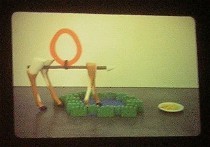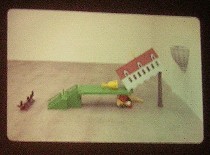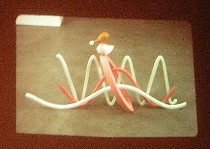 Feeling beaten down by so much academy-style art, lately, I pointed my nose toward the Matthew Ronay talk at the place that specializes in all that academy-style art, the Pennsylvania Academy of the Fine Arts (here’s my post on the series of upcoming artists’ talks there).
Feeling beaten down by so much academy-style art, lately, I pointed my nose toward the Matthew Ronay talk at the place that specializes in all that academy-style art, the Pennsylvania Academy of the Fine Arts (here’s my post on the series of upcoming artists’ talks there).
Ronay was one of the artists at the Whitney Biennial this year, and you didn’t hear anything about him from either Roberta or me because neither one of us was too crazy about his installation, “’70s Funk Concert Model” (left).
Nonetheless, I was yearning for something hip and New York and NEWWW after all that old-fashioned painting.
Ronay (accent on the last syllable) is a cute 30ish guy, not too tall, a little scruffy, and he makes art that’s also cute, not too tall, but not in the least scruffy. The Brooklyn-based artist was introduced as a maker of super-realist miniatures.
I’m taking a moment to look up super-realist. hold onnnnnn……
From World-Wide Arts Resources:
The Hyper-realism movement originated in the late sixties and early seventies when artists began producing paintings that appeared to be photographs. In painting, Hyper-realism is synonymous to Photo-Realism. Also know as Superrealism, the movement was most popular in the United States but spread to some parts of Western Europe. In the sculpture medium, artist often used casts of the human figure to create true-to-form…
No. I don’t think so. What I saw were pop-color painted shapes that have a jaunty, up-beat look. Clearly the guy is not a super-realist. What he does make are (sometimes super-sized) cartoon shapes in 3-D, made from strata of MDF board and sanded to mass-produced-looking perfection. I have to go with Pop, not Super-Realist.
Ronay himself is a funny mix of upbeat and downbeat all at once, political and not political.
 He started out by saying he wasn’t a political artist, but he bemoaned the current absence of cultural artifacts making reference to what’s going on in the (political) world.
He started out by saying he wasn’t a political artist, but he bemoaned the current absence of cultural artifacts making reference to what’s going on in the (political) world.
His piece at the Whitney was a salute to three ’70s funk bands–Earth Wind & Fire, Curtis Mayfield and the Impressions, and Mandrill–that produced cultural artifacts of protest–i.e. protest songs (right, part of “’70s…” that salutes Mandrill, which Ronay described as being in the spirit of Henri Rousseau–“harmony in the jungle but some sense of danger”).
 Ronay added that what passes for culture now is Brittany Spears, and she, “is not articulating anything” (left, “Irreversible Algorithm” from “’70s…,” showing redesigned french fries being tested on animals).
Ronay added that what passes for culture now is Brittany Spears, and she, “is not articulating anything” (left, “Irreversible Algorithm” from “’70s…,” showing redesigned french fries being tested on animals).By saluting the three bands, Ronay is hoping to communicate that kind of political content without himself being political.
 So Ronay showed the lp covers from the three bands and he played performances from EW&F and Mandrill to show their approach to saving the world with peace and love (I’m translating what he said very very loosely). (Right, “Unfair Fulcrum,” a reference to George Washington Carver and the peanut versus corporate bureaucracy, is part of “’70s…”)
So Ronay showed the lp covers from the three bands and he played performances from EW&F and Mandrill to show their approach to saving the world with peace and love (I’m translating what he said very very loosely). (Right, “Unfair Fulcrum,” a reference to George Washington Carver and the peanut versus corporate bureaucracy, is part of “’70s…”)No way would you understand all this, looking at the installation. Nor did Ronay care if you didn’t get his narrative, although he had quite an elaborate one. “For me, you use your subconscious to inform you about what your conscious would never tell you,” and so he expects people to intuit what his work is getting at.
After all, he said, what people say they can see in Duchamp’s “The Bride Stripped Bare by her Bachelors, Even” is miles from the object Duchamp actually made.
 Here’s a sampling of some of the topics he talked about that related to his work–the merger of fundamentalism and capitalism into a government of pure evil; why people left Europe for North America (image left); ecological disaster and how it will play out, etc. etc. etc.
Here’s a sampling of some of the topics he talked about that related to his work–the merger of fundamentalism and capitalism into a government of pure evil; why people left Europe for North America (image left); ecological disaster and how it will play out, etc. etc. etc.
I suppose I found the Q&A to be the most enlightening part of the talk.
Here’s some of what he said in answer to questions:
I’m interested in a kind of oral tradition, using these contrived kinds of narratives as a possibility for thinking. It’s not the only interpretation.
I don’t want it to be about sculpture. It’s more about symbols and language. [He did say something about semaphores in the course of his talk, especially in reference to his biker-gang piece, but all I could think of were advertising logos.]
There is no initial idea. I do a lot of drawings. …They don’t come from me. They come from the energy of the universe. [Then, after editing the drawings several times he said he figures out what the project is about.]
I have all the time while I’m making stuff to invent the narrative (image right, from biker gang project, shows biker and his old lady engaging in sex on a waterbed with bucket of french fries at the perfect moment).
The paradox for me is I’m a maker. People who are conceptual artists put all this thought into something simple. [He saw his own work as needing to be read the same way we read conceptual work, bringing our own ideas to it.]
[He said his work was not surreal. Surrealism is about shock value, and his work is not about shock value.]
It’s an allegory. I don’t want to be a propaganda creator.
While the individual pieces Ronay makes are charming and cartoon-like, his installations are simply confusing to me, merging too many ideas and visual loci to make a coherent statement. Maybe if I were a New Age type, they’d just permeate my subconscious.
And I ought to mention, to give you a feel of things, that Ronay used a number of taboo words that we all use in private in the kind of public forum where you’d normally never hear them. I was sitting toward the front, but I could feel the intake of breaths behind me as he f-worded, c- and p-worded (male and female anatomy parts), and s-worded his way through the talk.
There’s a certain level of indulgence for young men and their incomprehensible stories (and their verbal inappropriateness). I think here of Matthew Ritchie and his cosmologies, as well as Paul Swenbeck, and his German legends.
But me, I think we ought to be able to access the meaning of the art some other way besides New Age subconsciousness. I should have known what I was in for at the beginning of the talk, when Ronay said that pop music had an advantage over art, because it had the advantages of language and accessibility. I read that as an excuse not to make his own work accessible.
There’s a paradox here, because visually, the objects are quite accessible, but the combos are inscrutable.
I happen to think that good art is accessible. It’s a problem when the artist doesn’t really care whether or not he communicates.










